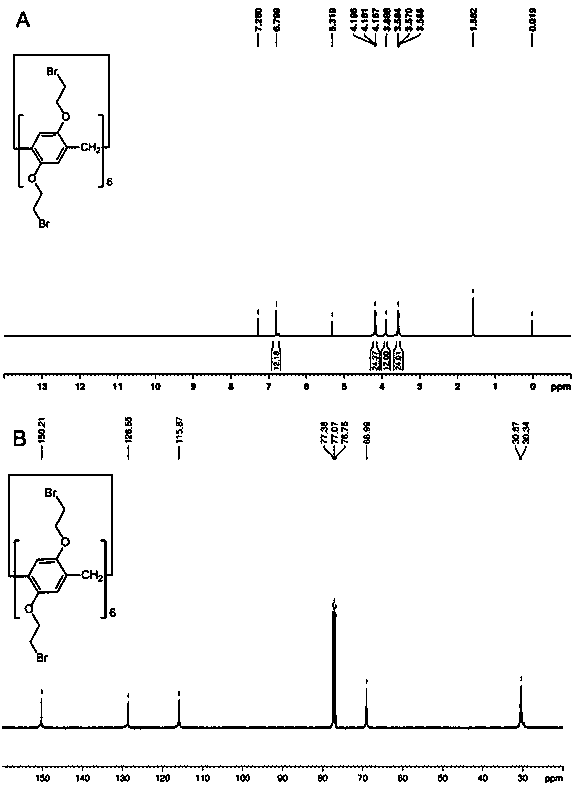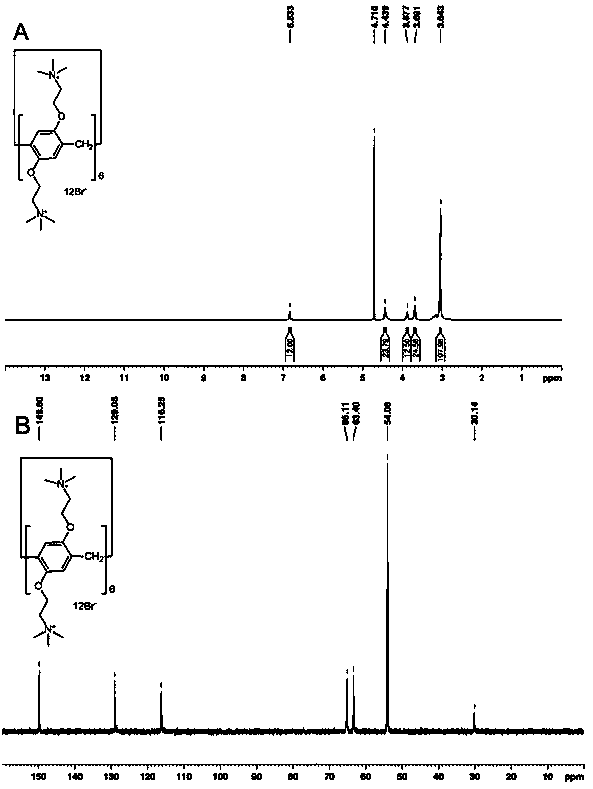Method for building fluorescent sensor based on competitive recognition and application
A fluorescent sensor and construction method technology, applied in the application field of insulin detection, can solve the problems of slow detection speed, low insulin recognition, complex insulin detection method, etc., and achieve the effect of simple method, broad market application prospect and high sensitivity
- Summary
- Abstract
- Description
- Claims
- Application Information
AI Technical Summary
Problems solved by technology
Method used
Image
Examples
Embodiment 1
[0029] Embodiment 1: The construction method of this fluorescent sensor based on competitive recognition is as follows:
[0030] (1) Put 10g of hydroquinone bis(2-hydroxyethyl)ether, 12.5g of triphenylphosphine, and 150mL of anhydrous acetonitrile into the flask in sequence, cool in an ice-water bath, stir and mix well, then add 25g of carbon tetrabromide , stirred at room temperature for 5 hours, after the reaction was complete, cold water was added to the mixture to quench the reaction, and a white precipitate was obtained, which was collected by filtration, washed 4 times with methanol aqueous solution (volume ratio 3:2), recrystallized with methanol, and dried Compound 1 was obtained afterward; the nuclear magnetic resonance spectrum of compound 1 1 H NMR and 13 C NMR ( figure 1 );
[0031] (2) Add 5g of compound 1 and 0.92g of paraformaldehyde into the flask, use 300mL of chloroform as the solvent, then add 4.38g of boron trifluoride ether, and react at room temperatur...
Embodiment 2
[0035] Embodiment 2: The construction method of this fluorescent sensor based on competitive recognition is as follows:
[0036] (1) Put 15g of hydroquinone bis(2-hydroxyethyl)ether, 35g of triphenylphosphine, and 300mL of anhydrous acetonitrile into a round-bottomed flask in turn, cool in an ice-water bath, stir and mix well, then add 75g of tetrabromide Carbon, stirred at room temperature for 4 hours, after the reaction was complete, 250 mL of cold water was added to the mixture to quench the reaction, and a white precipitate was obtained, which was collected by filtration, washed 3 times with methanol aqueous solution (volume ratio 3:2), and reconstituted with methanol Crystallization, white crystals 15.6g after drying, compound 1 1 H NMR and 13 C NMR ( figure 1 );
[0037] (2) Add 4g of compound 1 and 1g of paraformaldehyde into the flask, 350mL of chloroform as the solvent, then add 5g of boron trifluoride ether, and react at room temperature for 3 hours under nitrogen...
Embodiment 3
[0040] Example 3: Experiments on the Binding Constants of Rhodamine B and Cationized Pillar [6] Arenes, Insulin and Cationized Pillars [6] Arenes
[0041] Add 2 μmol / L CP6 solution to 2mL 10μmol / L RhB solution in batches, adding 10μl each time, to obtain a set of fluorescence absorption curves, and draw the corresponding linear relationship according to the curves ( Figure 9 A) to calculate the binding constant Ka between RhB and CP6 1 ( Figure 9 B), the excitation wavelength of this process is 510 nm. In the same way, add 2 μmol / L insulin solution to 2 mL 10 μmol / L CP6 solution in batches, adding 10 μl each time, to obtain a set of fluorescence absorption curves ( Figure 10 A), also make the corresponding linear relationship according to the curve, and calculate the binding constant Ka between CP6 and Ins 2 ( Figure 10 B); the binding constant Ka between CP6 and Ins 2 Greater than the binding constant Ka between RhB and CP6 1 ; The different competitive relationship...
PUM
 Login to View More
Login to View More Abstract
Description
Claims
Application Information
 Login to View More
Login to View More - R&D
- Intellectual Property
- Life Sciences
- Materials
- Tech Scout
- Unparalleled Data Quality
- Higher Quality Content
- 60% Fewer Hallucinations
Browse by: Latest US Patents, China's latest patents, Technical Efficacy Thesaurus, Application Domain, Technology Topic, Popular Technical Reports.
© 2025 PatSnap. All rights reserved.Legal|Privacy policy|Modern Slavery Act Transparency Statement|Sitemap|About US| Contact US: help@patsnap.com



